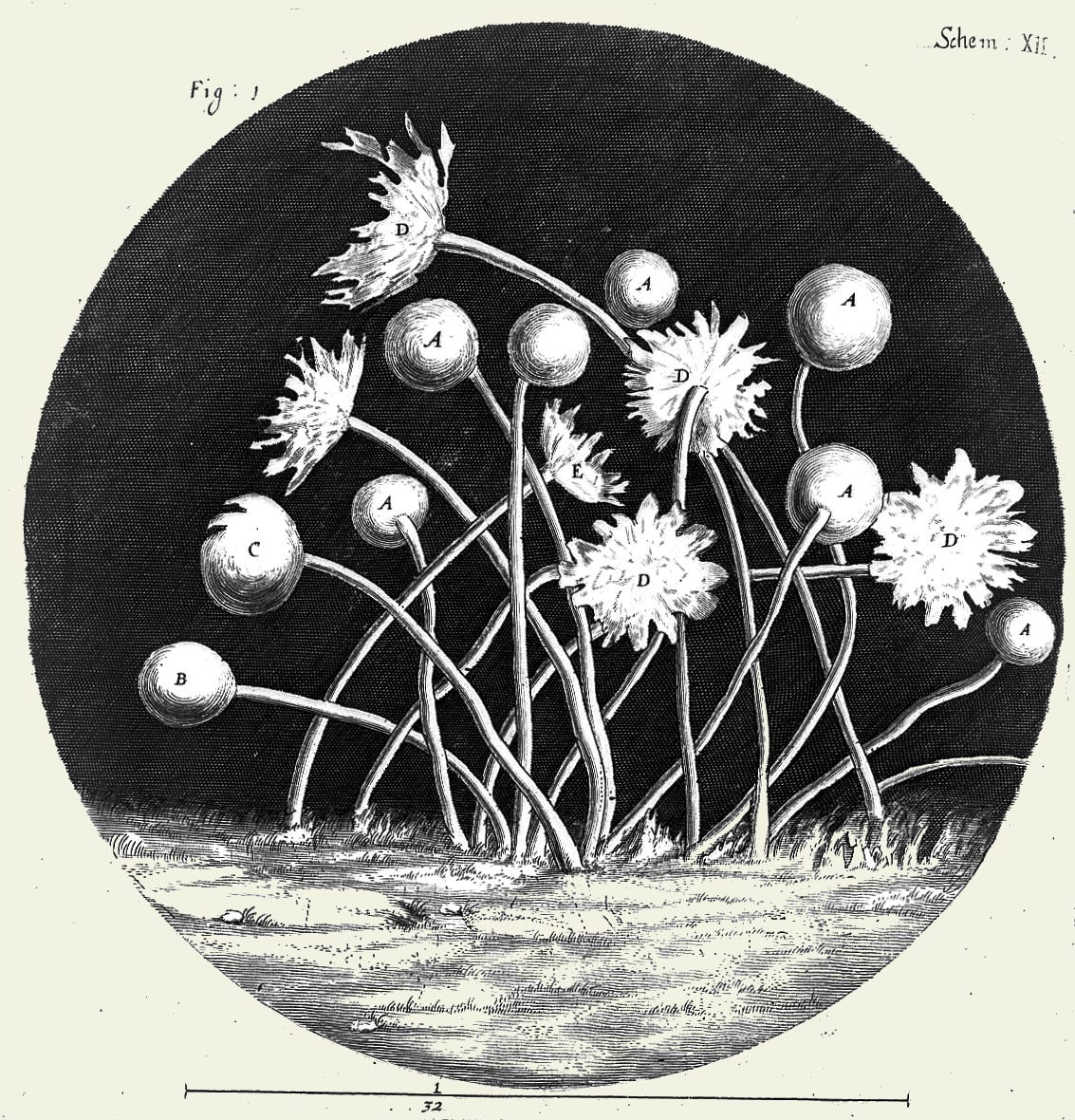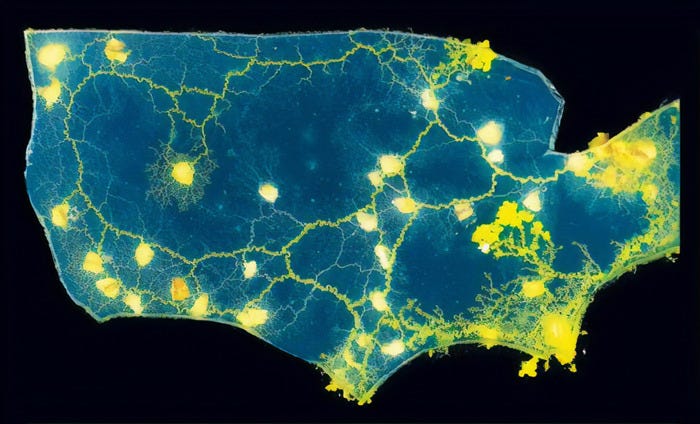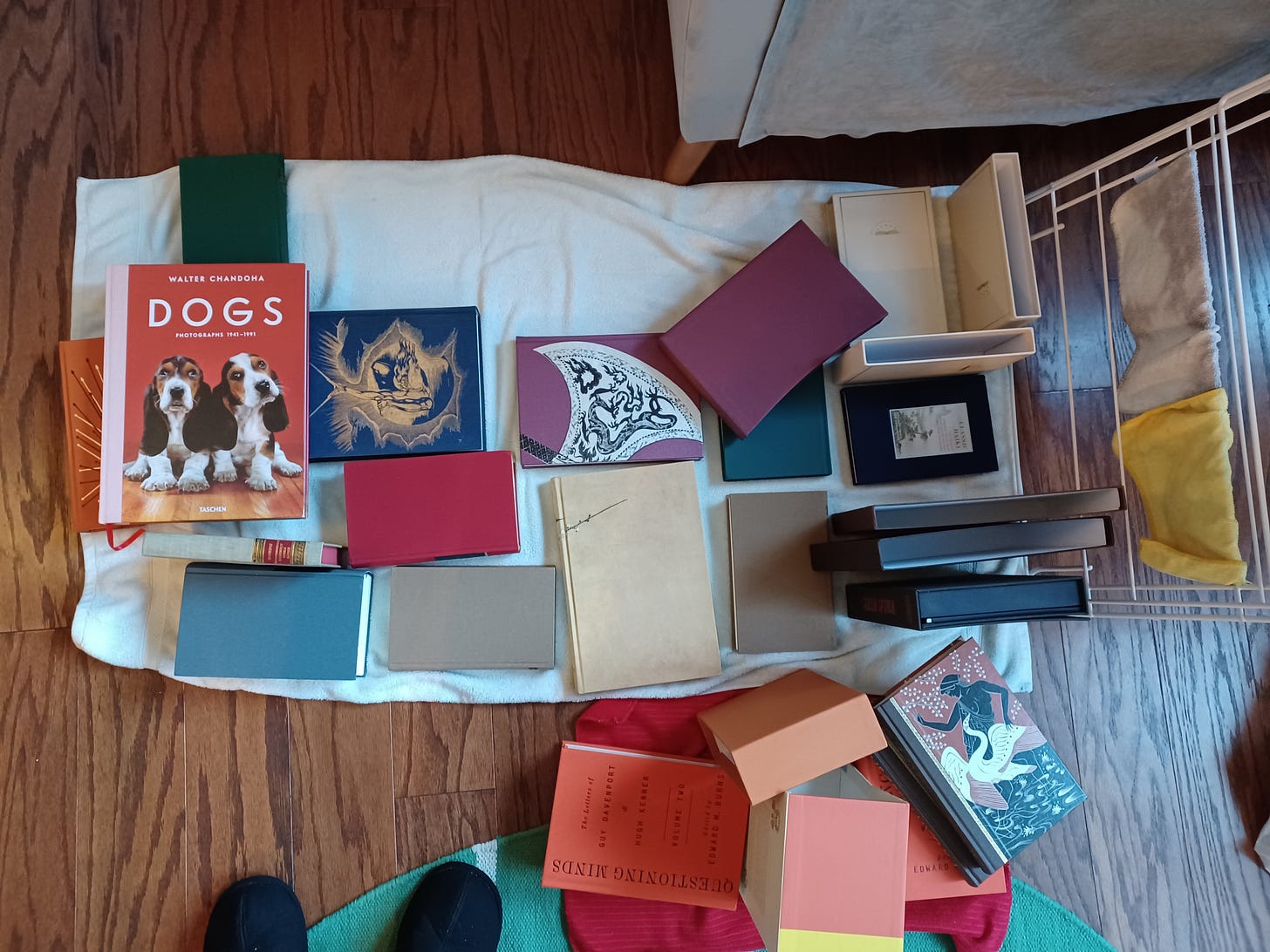Demolding My Library & the End of the World
Mold will consume us all, but it doesn't have to consume your books yet
A Freezer Full of Books
Last week, my freezer was full of books. Cold books feel weird in the hand, although that’s probably because they frustrate your mind’s long-standing expectation that books are, generally speaking, things that match room temperature. Then again, room temperature and the room where I keep my books were the source of the problem that fridged my books in the first place: my apartment was full of mold.
Philadelphia is a good town for mold. Built at the swampy confluence of the Schuylkill and Delaware rivers, the marshy ground, warm temperatures, and lack of strong winds for much of the year leads to musty, damp, humid air. This morning, relative humidity was nearly 90%; even now, it’s a muggy 72%.
Take that humidity into your home, raise the temperature to the 60s (Fahrenheit), and you have ideal conditions for cultivating all kinds of mold in your walls, cupboards, bathroom fixtures, and yes, your books. That's why the British Library recommends storing books in rooms with a humidity level between 45% to 55%, while the Library of Congress suggests as low as 35%. My apartment, I later found, was around 65%.
Like most responsible people, my wife and I regularly clean out mold in our bathroom, our sinks, toilet, and other normal places where mold gathers. I just didn’t think it would come for my books.
It was the dust that tipped me off. I dust my books regularly, but in recent months it seemed like I was doing it more often, to less effect. Frustrated, I finally decided to take down all my books and figure out how bad this dust really was. I picked up a big, slipcased Satyricon that had it especially bad. And there, on the back of the case, hidden from normal view, were coin-sized patches of bluish white, ragged fuzz. It was mold. It must have been there for months.

“Vegetation Arising From Putrefaction”
Defining mold is difficult. Most of them are considered a form of fungal growth, a particular kind of structure that a colony of microscopic fungi create in order to absorb nutrients and spread spores. A few of them aren’t fungi at all, like the famous Physarum polycephalum slime mold, which has been used to model network exchanges and subway maps. But fungi or not, all molds work in broadly similar ways: microscopic spores settle on something edible—anything organic, basically—consume it, multiply, and spread. As they spread out, these spores build networks of thread-like mycelia, roots that suck up nutrients from the surface it grows over. That mycelia is mold, and it was eating my books.
I took down my books and tried to figure out the extent of the damage. A few books were too far gone to save. The mold had spread from the covers to the pages, and completely cleaning them would cause too much damage to the book. The rest had everything from a light dusting of white mold on the spines to those fuzzy patches I saw on my Satyricon.
Ironically, it was my big, expensive books, made with quality materials and longevity in mind, that were hit the hardest. Fine cloth and leather are good for preservation, but they’re also packed with mold-friendly nutrients. My cheap paperbacks, on the other hand, were mostly covered in glossy, plastic laminate, inedible to fungal spores.
But all of my books were in trouble: covers might absorb most mold spores, but left long enough, it would spread to the page block, and then onto individual pages. At that point, mold is much harder to stop.
Reader, I was terrified. Mold is natural and necessary to the functioning of the organic world—they recycle nutrients from dead matter back into the world, clearing out the dead and making room for the living—but mold is also disgusting. It is a mindless, creeping thing that eats up your home and your belongings. It can make you sick, or even kill you. And it is everywhere, all the time, waiting for the right conditions to grow. A thousand fungal spores brush against your face every time you cross a room.
So I spent a few minutes pacing around my piles of moldy books, trying not to panic at the prospect of my favorite possessions, some of them irreplaceable, rotting away into fungus-food. I try to keep a healthy, detached attitude towards my personal belongings, but I make an exception for my books. They are an extension of my mind, markers of my travels, and tokens of my accomplishments. My life is markedly worse without them.
All the while, my wife, the practical one in the family, was busy Googling away, finding the right thing to do, making lists of things to run out and buy. I got myself together, and we set about demolding my books.
How to Demold Your Books
There is no shortage of mold-prevention and clean-up information available online, and you wouldn't have read this far into my story if you were desperately seeking tips on fighting book mold. Still, here is the basic process for mold mitigation, as summarized by a dozen articles across a dozen sources. Here's the process we settled on:
1. Wear Masks and Gloves
You're going to be spreading a lot of fungal spores into the air as you do this. Keep the air circulating, your face covered, and your hands gloved. You never know if the mold you're handling is toxic, or might trigger an allergic reaction.
2. Remove All Books
Not just the obviously moldy ones, but all of them. Any book with visible mold has probably been sprouting for a while, spreading into both the air and the shelves around it, and you will need to clean them all.
3. Dry Cleaning
Once you've piled up your books for cleaning, you need to clean them with a dry electrostatic cloth. Wipe the whole outer surface of the book, from the outside cover to the page block to the inside covers. Briefly flip through the book and look for any signs of mold inside, and brush that away, too. If any deep mold stains remain, brush them vigorously with a dry toothbrush.
4. Wet Cleaning
This one is going to violate all sense of bookish decorum, but it's crucial to clean your books with some kind of wet, chemical solution to kill as much fungus as possible. There are all kinds of recommendations here, from diluted bleach to alcohol wipes. My wife and I settled on dampening rags with a 3% hydrogen peroxide solution. Peroxide can cause discoloration, but bleach and alcohol are more likely to dry out paper and destroy its chemical bonds. Very few of my books are illustrated, so peroxide seemed like the better choice. We poured the solution into a spray bottle and lightly spritzed a cloth, then rubbed entire outer surface of each book.
5. Drying
For obvious reasons, you're going to want to dry your wet-cleaned books with a clean cloth as soon as possible.
6. Freezing (Optional)
For the worst cases, especially when they were rare or valuable books, we wrapped the books up in dry rags, stuffed them into Ziploc bags, and put them in the freezer. This doesn't kill fungi, but it does cause them to hibernate and stop growing.
We did this for every book in the apartment, then cleaned the shelves. In this way, we passed most of an afternoon, watching shitty TV shows and scrubbing away at all of our books. After you get into a rhythm, the work is pretty satisfying. It felt good knowing that I was regaining control over my home's microbial ecology.
But this was only a temporary fix. Short of soaking everything in bleach for an hour, there's no way to manually remove all fungal spores from your home. Fungi are everywhere, every place, all the time. The only thing keeping them from constant, rampant growth in every room of every house is keeping an environment hostile to mold growth. More than anything else, that meant getting our room's humidity down to reasonable, non-swampy levels. In Philadelphia, that means getting a dehumidifier.
A few days later, the big machine was sitting in my living room, humming away. When we first plugged it in, relative humidity in our room was at 65%, which is pretty much a welcome mat for mold. Within a day, we'd gotten the room down to about 50%, and now keep it around 45%, running the air conditioner periodically to circulate the air. I took the books out of the freezer, which seemed unharmed by the process.
As I write this, we've now had the dehumidifier for a couple of weeks. My apartment is, for now, an anti-mold zone, with no signs of new infestation. My books are clean and safe.
Postscript: The End of the World
But all this is temporary. Besides techniques in mold prevention and the feel of a frozen book, what has stayed with me most since demolding my library has been the mental image of my books, my shelves, and my home overrun with fuzzy, slimy, blooming mold. Humidifiers and hydrogen peroxide are only temporary on the time scale of molds, which have been around for a billion years.
I can keep my books safe for now. When I die, my friends and family can keep my books, but as they die off or simply lose interest, the same fates will befall all of my books: they will be abandoned, discarded, pulped, or burnt. Not today or tomorrow, or next year, but in centuries to come, all of them will eventually become a feast for fungus. That's the real end of books: not TikTok or AI, but mold.

But why stop at books? In the end, mold will get everything it can. Mold will rule over our landfills, finding every bit of corkboard, plywood, and paper we took from the forests and returning them to the soil as loam; mold will eat the floorboards out from under your feet long after you are gone, and it will eat you and me; mold will cover the bodies of all the abandoned dead, the fallen trees, the old benches and fences left to rot, which must return to where they came from; mold will slither up the steel skeletons of our empty skyscrapers, finding every scrap of organic material hidden behind glass, metal, and plastic, and carry it down, lovingly, back to the soil through tendrils of mycelia that stretch for miles. Mold will eat everything that dies, and give it back to everything that lives. Mold is rot and rejuvenation, it is death and rebirth, it is the end and it is the beginning, and there is nothing so permanent that we can do to ourselves and our world that mold and time will not undo.
But I am not ready to admit this to myself yet, not ready to submit to this inevitable fact, so I turn on my new dehumidifier, and set the humidity to a book-friendly 45%, and dust my books again.
From the Archives
This week saw a lot of new traffic and several new subscriptions, which is heartening. For those who missed it the first time around, here’s one of my hits from last year: how does the Olympic Parade of Nations get sorted in countries that don’t have alphabets or alphabetical order?
And that’s it for this week. Happy reading!




